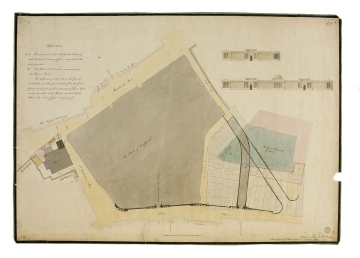
Browse
Reference number
Purpose
Aspect
Scale
Inscribed
Signed and dated
- Copied Novr 1st 1808 from / the original plan made in March 1800
Medium and dimensions
Hand
Notes
The drawing shows the holdings to the south-east. In 1800 the Bank gained permission from Parliament for widening Bartholomew Lane by pulling down these four houses and inserting a footpath through part of the tower of St Bartholomew's Church. This plan was never executed because of the death of the Bishop of London in May 1808, with whom the negotiations had been made; his successor was less amenable. Later, in 1825, the Bank intended to submit another proposal but the financial crisis of that year led to further postponement.
Literature: W. Marston Acres, The Bank of England from within, Oxford, 1931. pp. 397, 476-477
Level
Sir John Soane's collection includes some 30,000 architectural, design and topographical drawings which is a very important resource for scholars worldwide. His was the first architect’s collection to attempt to preserve the best in design for the architectural profession in the future, and it did so by assembling as exemplars surviving drawings by great Renaissance masters and by the leading architects in Britain in the 17th and 18th centuries and his near contemporaries such as Sir William Chambers, Robert Adam and George Dance the Younger. These drawings sit side by side with 9,000 drawings in Soane’s own hand or those of the pupils in his office, covering his early work as a student, his time in Italy and the drawings produced in the course of his architectural practice from 1780 until the 1830s.
Browse (via the vertical menu to the left) and search results for Drawings include a mixture of Concise catalogue records – drawn from an outline list of the collection – and fuller records where drawings have been catalogued in more detail (an ongoing process).

